March 17 is typically when I started my garden when we lived in Connecticut. Not here in coastal southern California. We garden year-round. But this year, we are facing record-breaking heat. This was the hottest winter I can remember. We just had four days of record-breaking heat that fried a number of my plants in containers, including my beautiful new flower baskets.
Even the famed California poppies in the Antelope Valley were fried, and those are desert-adapted native plants. We live in interesting times, an era when all of the world except the right-wing folks in the USA know that the climate is changing, and that man is causing it. Well, I do what I can to reduce my CO2 emissions, and keep on gardening.
Because this winter had so few winter chill hours, my fruit trees are blooming rather sporadically. Some branches of the apricot tree were loaded with flowers. Other branches produced only leaves. Overall, I got about half the blossoms I would have expected.

Some of the apricot blossoms are producing fruit. So far, I can count about a dozen apricots. Since there were nearly a hundred blossoms on the tree, I am hoping for more than the half dozen apricots on this branch.
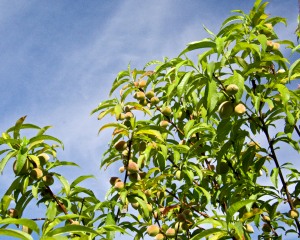
The Florida Prince peach tree has a very low chill requirement, and it has set fruit magnificently. The other trees, not so much.
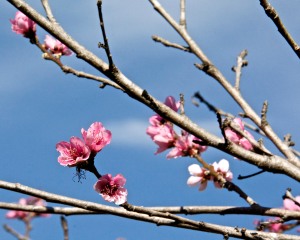
The Panamint nectarine is blooming now, but most branches have no blossoms on them. The poor Babcock Peach tree has only three blooms on it. Maybe more will open later. Hope so. So far, there are no flowers on the Snow Queen nectarine.

The ultra dwarf GoldMine peach has two clusters of blossoms, quite surprising since it requires 450 hours of chill and we got fewer than 80 winter chill hours.
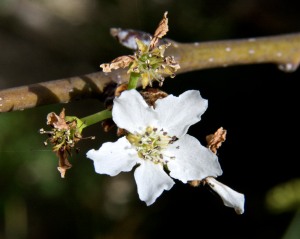
One of the Asian pear trees had 28 blossoms on it. The other two Asian pears have fewer than 10 flowers each. I am hoping that more flowers might open on them next week or the week after. We love those Asian pears.
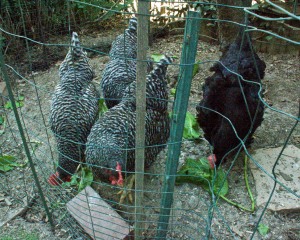
We are getting an average of two eggs a day from our four hens. They are no longer spring chickens, and production is down. I am still debating whether to get more hens this year or wait until next year.

The artichokes are producing flower buds. It is always a challenge to know how long to wait before harvesting the bud. I will want to catch it well before it starts to open for the most tender flesh.

This is the onion end of the front veggie bed. I planted about 120 tiny onion seedlings. Only 80 survived.
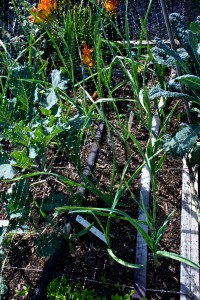
I planted one clove of elephant garlic and 29 cloves of regular garlic. Only one of the regular garlics failed to sprout. I may end up with far more garlic than I need. What was I thinking? Apparently that I like garlic. No werewolves near my garden.

I have a small bed in front that is filled with arugula, chard, red frilly mustard, and bok choy, all doing well. The path is blocked by an abundance of dinosaur kale.
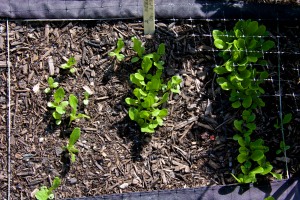
And Deer-tongue Lettuce. I can hardly wait until this stuff is ripe. Not pictured–Komatsuna, an Asian mustard green.
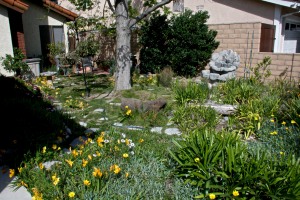
This is the non-vegetable garden part of the front yard. It is in full bloom in February-March, such a pretty time here.
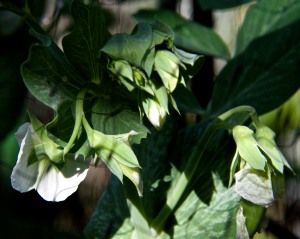
Yippee, my first snow peas are in bloom in back. These are Oregon Sugar Pod. I planted the sugar snap peas later, so they aren’t blooming yet. And the Mammoth Snow Peas are just now sprouting. The netting is doing its job of keeping the birds off the shoots and flowers. Maybe I will get a pea harvest this year.

The citrus trees are all blooming magnificently, as well as our avocado tree. We have Navel and Valencia Orange trees, Eureka and Meyer Lemon, and Bearss Lime. Should be a great harvest next winter, God willing and the creek don’t rise.
Because my garden seems to be off to such a good start, I have nudged my harvest goal for the year upward to 200 lbs. That may be a challenge if the fruit trees don’t set or if we keep having these wilting heat waves. As of February 28, I have harvested 26 lbs of fruit and 3 lbs of vegetables, plus 42 eggs. The fruits were 1 Granny Smith apple that came from an autumn blossom rather than the usual May blossoms. I’m telling you, the weather has gotten WEIRD. Also two Eureka lemons, a passel of limes, and both Navel and Valencia oranges.
The vegetables harvests included arugula, bell peppers (in January and February–this was a warm winter, folks), collard greens, herbs, kale, lettuce, green onions, and radishes. Most of the collard greens go to the chickens, along with sorrel, arugula, and nasturtiums. I don’t weigh the harvests that the chickens eat.
The red cabbage is curling up, and assuming that it isn’t from disease, we may get some cabbage soon, as well as cauliflower. I have high hopes for my 2015 garden.

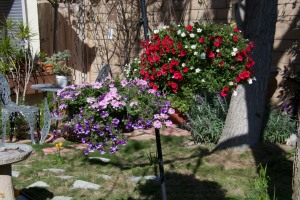
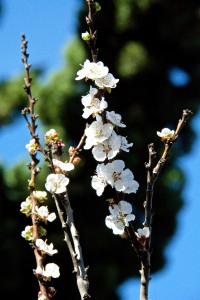

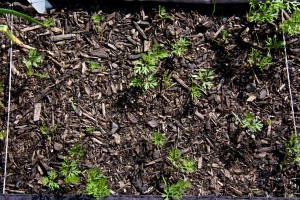
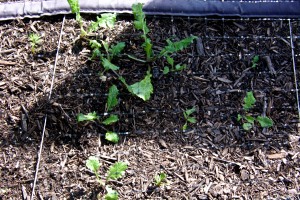
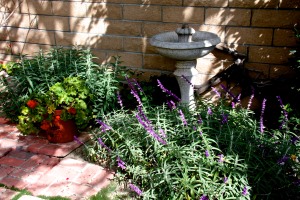



Good luck with your goal. That one peach tree looks like it will help out a lot.
LikeLike
Daphne, I am counting on that one peach tree and my citrus plus avocados to bring in the poundage this year.
LikeLike
Lou, Thank you for that wonderful blog about snow peas! Vic
LikeLike
Silly Vic. As resident spousal unit, Vic enjoys snow peas from the garden. That and green beans are about the extent of his interest in my gardening activities.
LikeLike
Lou, everything looks great! So, a few didn’t take the heat, you are still way ahead with your garden.
LikeLike
Thanks, Mary. It is a challenge gardening with Global Weirding going on. My May Pride had 19 blossoms on it, but it set only three peaches.
LikeLike
Thanks for the garden tour, a lot going on, so exciting. So many peaches on the tree, hope you get the ripe ones before the critters.
LikeLike
Norma, it is always a challenge to beat the critters to my produce.
LikeLike
Wonderful tour. It looks like you will at least have some fruit this year, so that’s good. It’s so strange how the west is so much hotter than usual while the east is the complete opposite. And I really like that meditation garden – what a great idea!
LikeLike
Margaret, I agree. We have had record-breakikng heat, while the east and north have had record-breaking cold. I call it Global Weirding. Global Climate Change isn’t just about a hotter planet, it causes more unreliable weather and more severe everything–storms, droughts, floods, heat waves. It makes growing food a challenge.
LikeLike